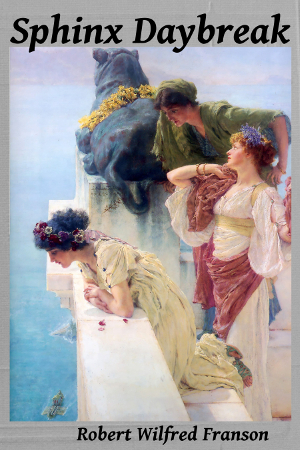Sphinx Daybreak
by Robert Wilfred Franson
225,000 words; 604 pages
Kindle; KDP Print: 2018
 Literature up in the air
Literature up in the air
Robert Wilfred Franson's Sphinx Daybreak. How to begin doing justice to this rich, astonishing flight of imagination? The author himself will accept that it's science fiction, or that it's fantasy, your choice. So there's no beginning with such a label. Though "sui generis" might do.
To go beyond solid entertainment and engaging flight of fancy, and on to the status of literature, a story arguably must not just feature human nature in the fable's entertainment and fancy, which can hardly be helped; it must delve into it thematically, tell us something, and make us wonder. If that, plus strong writing, makes literature, then there you have it in Sphinx Daybreak.
Taking science fiction and fantasy as the imaginative literatures, they can also encompass non-human nature and illustrate the highs and lows across species and types, tying together good and strong — and even heroic — character as something universal, in contrast with the weak and the bad. While still finding something humanly salvageable in the in-between. And with us learning from all that, and taking heart that it's the good people (human or otherwise) who can be the stronger and more effective in acting together to achieve their individual and common salvation.
So — on to the situation. Many a story asks what if, to present an alternate future; what if the American South had succeeded in seceding; what then a century or two later? But what of the reverse? What if a far different past led to our actual present? As explained on the back cover:
Before the Wright Brothers opened the era of mechanical, powered flight in 1903, the daytime skies above Earth were populous and busy. In the Middle Air were hidden the vast sunny cloudland of the Walking-Deck and smaller cloud-isles like Athenaeum and Swan, inhabited by humans since the fall of Troy and by aircats longer than that. In the Lower Air was the gossamer swirl of Springfolden, inhabited for long millennia by the more-or-less intelligent etherine vortices whom men called djinn.
The obvious question is, how do we not know any of this today? What happened to that regime, that it did not continue as-is, and that its denizens did not finally announce themselves and sway our twentieth-century development — and, while it still could, even take control of the Downlands — the Earth's surface and its people — before the coming scientific and technical explosion could threaten it?
Indeed, change was in the air in the physical sense too:
Yet in the Nineteenth Century, volcanic turbulence disintegrated Springfolden and later burnt the Walking-Deck. In 1904, the long-lived Luftmenschen — both humans and aircats — were coming to terms with the wreckage of their comfortable way of life; as the djinn in their own way were as well.
Our hero, Hendrik Rheinallt of the Luftmenschen, is too well-centered and too engaged with the short-term and long-term issues of his struggle ever to think of himself as heroic. His aircat counterpart being Arahant. Between the two of them, they define the very essence of thoughtful, responsible, determined benevolence; for this is the very character that is required for possessing the capability of saving the world from a disaster of historical proportions. Actually, several worlds.
It is notable that we follow only Rheinallt as our viewpoint over the whole 600 pages. That is what it takes for us to experience things not just through his eyes, but — continually from scene to scene, all the way through — to experience everything through the prism of his heroic purpose and values. We care as we do all the way through the story because of this. Yes, there are a multitude of often startling characters (such as Arahant's various sisters and — non-spoiler alert — Heraclitus, alive still in our river of time). But we don't switch between players as we proceed, in the name of inhabiting all sides and grasping all interior motives, exalted and base alike. No, the literary purpose here is to showcase the only human qualities that may secure a good life for the whole wide world, on into a long future. It is Rheinallt most deeply of all who possesses them.
And the detail! The page-in and page-out wonderful detail in rendering this literary world, in making it make so much sense despite the unrelenting imagination that pervades it, is not just satisfying. It's necessary. As reader, for you to find it vital that a world be saved, and to find admirable real beings in this world who must save it and be saved, you have to know that world and its beings as if it's your own. You have to be there. In Sphinx Daybreak, you are there.
© 2018 Dean M. Sandin
Cover painting:
"A Coign of Vantage"
by Lawrence Alma-Tadema
1895
The Lofting Agency
the portal to Franson books
Antiquity at Troynovant
ancient times;
Classical world & worldview:
base and noble people, events, ideas
Breathers at Troynovant
lifeforms & biologic processes:
wildlife & pets, evolution & ecology,
health, medicine, & disease
Gravity at Troynovant
gravitation & contragravity:
applied, shaped, & redirected
Guise at Troynovant
masks, disguise & camouflage;
roles, acting, reenactment
Livelong at Troynovant
longevity & immortality
Mentality at Troynovant
the mind and mental operation
Peace at Troynovant
happy interregnum betwixt war & war:
"peace in our time",
Occupation & Reconstruction,
Home Front, veterans
Philosophy at Troynovant
nature of existence; history of ideas
Remembrance at Troynovant
memory, remembering, & fame
Transport at Troynovant
ships, trains, autos, aircraft, spacecraft
| Troynovant, or Renewing Troy: | New | Contents | |||
| recurrent inspiration | Recent Updates | |||
|
www.Troynovant.com |
||||
|
Reviews |
||||
| Personae | Strata | Topography |
|
|||